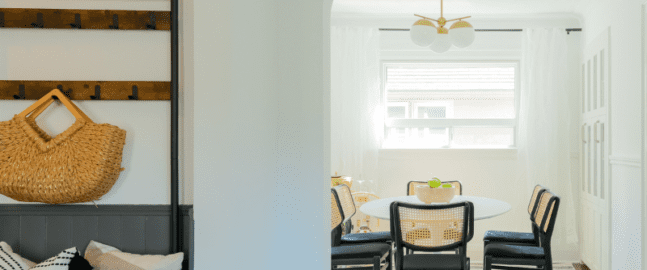In the fast-evolving world of real estate, standing out has never been more critical. The battle for attention and appeal is constantly morphing, and now, a new contender has stepped into the ring – virtual staging. But before you rush to the latest and seemingly most convenient solution, it’s worth considering whether the traditional approach might still hold a prized place in your toolkit. Here, we’ll stage our own debate, dissecting the strengths and weaknesses of each method to help you, the real estate professional, make informed decisions that bolster your business.
Understanding the Staging Scene
To set the stage appropriately, it’s essential to know our players.
Traditional Staging: Imagine a dilapidated shell of a home. Now enrich its every room with the warmth of fresh paint, carefully selected furniture, cheerful art on the walls, and vases of fresh flowers. This is the magic that traditional staging performs, turning the intangible atmosphere of a dwelling into something a potential buyer can practically touch and unequivocally feel.
Virtual Staging: In the digital realm, technology wields this art, capable of transforming the same empty space into an enviable interior with a few clicks. Detailed renderings overlay the reality, offering a glimpse of a home’s potential. It’s a powerful illusion, one that leverages the efficiency and reach of online listings.
Both methods share the same ambition – to bridge the emotional gap between buyer and home – but the paths they take, and their efficacy along the way, diverge significantly.
The Case for Virtual Staging
Speed to Market: A virtual staging session can be completed in mere hours, a contrast to the logistical complexity of traditional arrangements.
Cost-Effectiveness: By bypassing the need for physical furnishings and labor, virtual staging can minimize expenses and be the frugal choice.
Customization and Flexibility: Virtual staging allows you to tailor the presentation to diverse tastes, swapping looks with ease and expanding the appeal of a single property.
These are compelling reasons, but are they enough to close the case? Not quite.
The Uns(taged) Side of Virtual Staging
Misleading Portrayals: A virtual space can be a pixel-perfect reflection of an idealized home not grounded in the actual property, a practice that can mislead and disappoint potential buyers.
The Tangibility Deficiency: While visually engaging on screen, virtual decors lack the physical presence that often seals the deal during open houses and showings, leaving something intangibly desired.
Technical Talents Required: To avoid the pitfalls of artificiality and enhanced quality, you’ll need the eye of a designer and the hand of a skilled technician. Otherwise, the result could undermine your buyer’s trust.
Tradition’s Unspoken Volumes
Crossing the Digital Divide: Staged homes engage with buyers on multiple levels. The tactile and visual harmony of a traditionally staged house elicits emotional connections, and a sense of “home.”
Building Trust: A picture may say a thousand words, but a staged home speaks honesty. Virtual renderings, no matter how exquisite, can’t shake the impression of a sales pitch. Whereas with traditionally staged properties, potential buyers not only get to see, but also experience the genuine real deal.
Return on Trust: Studies show that traditional staging delivers a significant return on investment, shorter listing times, and more generous offers. These are tangible results in a skeptical market.
The Ver(Staged) Dict
While the allure of virtual staging is undeniable, the calculus of trust in real estate remains. In the context of timeless human emotions and trust-building, traditional staging emerges not as a vestige of the past, but as an anchor to ageless principles. Its personal touch delivers where pixels and screens may falter.
To excel in an environment where competition is virtual but trust is palpable, consider each tool as complementary rather than competitive. Use virtual staging to expand your properties’ appeal online, but rely on traditional staging to anchor that appeal in the reality of the space.
Remember, in the narrative of a home, the chapters of its past and present are as essential as the aspirations of its future. It is in blending these elements, in staging the seamless transition from one to the other, that a true real estate story is told – and lastingly remembered.
The Lux Difference
Lux Furniture Rentals – where exceptional quality meets immaculate design. Tailored for the discerning tastes of real estate agents, interior designers, and home stagers, we offer an unparalleled selection of upscale furniture and décor that transforms any space into an inviting haven.
Born from the collaboration between an experienced agent and a visionary stager, Lux is committed to elevating interiors with pieces that resonate elegance and sophistication. Our luxurious collection has been handpicked by designers for designers, ensuring each item embodies luxury and finesse.
Imagine staging a home where every corner tells a story of comfort and style, where potential buyers can truly envision their future. With Lux, that vision becomes a reality. Our premium furnishings and décor items not only enhance the aesthetic of a room but also stir the imagination of buyers, helping them see the space as their own.
At Lux, we understand the impact of a meticulously staged property. We reject the notion of cutting corners with subpar items; instead, we provide you with opulent choices that make a statement. It’s not just about staging; it’s about creating an experience – one that leads to a sold sign on the front lawn.
Elevate your next project with Lux Furniture Rentals and experience the difference that luxury can make. Step into a world where style reigns supreme, and allow us to help you captivate your clients and close deals with confidence. Discover the Lux difference today.


